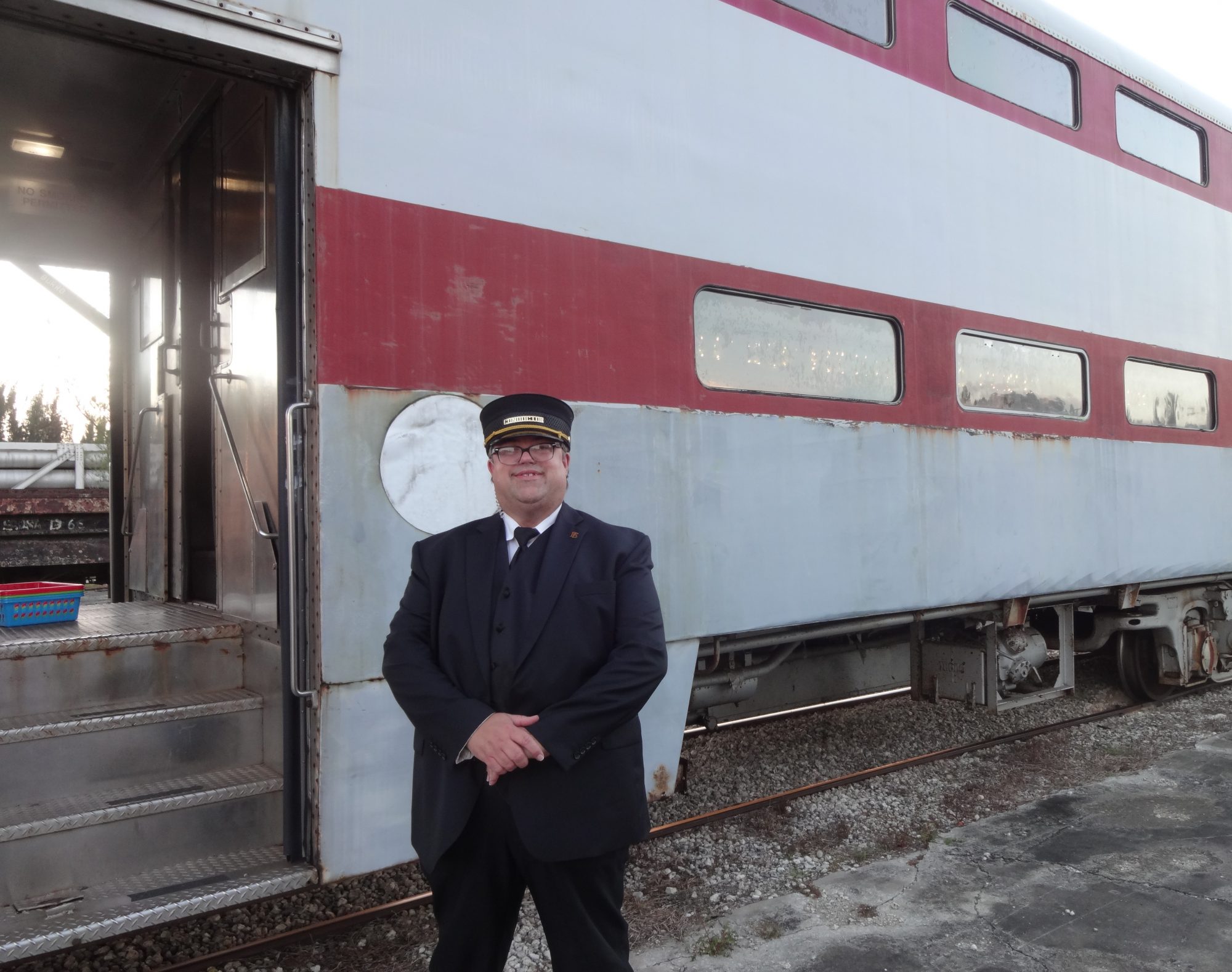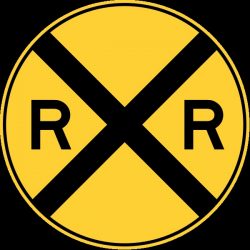Here we are for yet plenty of fun weekends on the rails here at the Florida Railroad Museum! Sounds like a great time to get a jump start on the more responsibilities that are to come as far as being on the train crew is concerned.
It’s Saturday morning, 18 January 2014. Believe me, it was a nice yet cold morning in the Willow yard as I got ready to meet the day’s crew including the conductor for our regular train rides. Just after I put my stuff away in the ACL 250 lounge car I got a preview of more responsibilities that are yet to come being a train crew volunteer.
When we returned from our two week hiatus over the holidays, I finally became a certified Car Host, which essentially paves the way for me to train to move myself up in the volunteer train crew hierarchy, and that would be Trainman. Now I don’t have to write the word “training” as a Car Host in my service record!
That said, let the Trainman games begin.
My first task was to start the generator in the ACL 250 car. Starting it is very simple, but you got to know what you are doing. First, unplug the extension cord in order to avoid backfeed when the generator is started. Second, check the oil level in the generator to see if it’s sufficient, which it is. Third, flip the switch and wait for the lights to flash. Fourth, press the Manual button and hold until the generator starts.
In two seconds, the generator springs to life. So far so good!
Finally, flip the breaker switch to the left of the generator. That turns on the heater on board the ACL 250, which was desperately needed due to the bitter cold weather outside. Within a few minutes we had a comfortable temperature in the ACL 250!
And one more thing: Plug the cord into the receptacle on board. Now we’re ready to go!
Time for me to go back inside the train and review the conductor’s logs. Make sure that the cars have been filled with water, which has already been taken care of.
Once we were on our way south to Parrish, I get my next responsibility while under the supervision of a certified Trainman on duty: Operating the tail hose while we are in a reversing mode from Willow to Parrish. First order of the day was for me to connect the tail hose to the rear of the train:
1. Connect the tail hose to the air hose.
2. Open the angle cock, a valve that permits air to pass through.
3. Test the tail hose when air pressure from the locomotive is good.
Then it was back on the train for the six and a half mile trip to Parrish. Using my radio, I have to communicate to the engineer all the mile posts from Willow to Parrish:
Mile Post 855. Clear track.
Mile Post 856. Clear track.
Mile Post 857 (Nichols). Clear track.
Then I get my next task as we approach Mile Post 858: How many cars to Dickey Road? As we had five cars in our consist calling those car lengths can get a little tricky at first, but it takes practice. And practice I must.
So, I prepare myself for Dickey Road 1,500 feet prior at the whistle board. After all, this is equivalent to around 15 cars; after all, a typical passenger railroad car is 85 feet.
Get to a landmark and announce on the radio to the engineer:
Five cars to Dickey Road.
Four cars.
Three cars.
Two cars.
One car.
And…
Clear Dickey Road, clear track southbound. Sound the tail hose whistle in the format of Morse Code Q, long, long, short and long – the last long is sounded on the crossing itself.
My car counts were good on the first try, but I still need practice. Continue south to Parrish.
Into the curve. Once out of the curve, go on the radio and tell the engineer “out of the curve, clear track”.
Mile Post 859 clear track. Engineer replies clear track. (We’re under the Florida Power & Light power lines coming from the Manatee Power Plant here).
Next up, the Parrish switch where we store our cabooses on the side track near the Parrish station. Do the car length calls again:
Five cars to the Parrish switch.
Four cars.
Three cars.
Two cars.
One car.
And…
Clear Parrish switch, clear track to standing equipment. Standing equipment?
Yes, there is standing equipment on the right hand side as you approach Parrish coming south. First, you got the two cabooses, then the Bradenton sleeper and the ticket office/gift shop. Get on radio and advise of standing equipment.
Once past the standing equipment, the conductor takes control of the train as we approach the Parrish ramp. I pass control of the train over to the conductor so that the train can be properly lined up with the ramp.
After we align with the ramp properly, we come to a stop in Parrish. My next task is to disconnect the tail hose from the air hose, but I have to call the engineer for a three step prior to turning the angle cock closed.
Three step? What is a three step?
Well, a three step is a Trainman’s best friend as far as safety is concerned. When a three step is called, the engineer will do the following in the locomotive:
1. Set the generator field switch off.
2. Apply the independent brake.
3. Set the reverser in neutral.
Now that three step is applied, I can go ahead and turn the angle cock the other way to closed so that I can remove the tail hose. Turn the angle cock closed and wait a minute or two. Then disconnect the tail hose from the air hose. Mission accomplished, return tail hose to conductor’s office!
Don’t forget to release the three step when done! It’s simple as calling the engineer on the radio and requesting the three step release.
Back on board, I change gears into my certified Car Host mode and head to my assigned car, ready to take on the morning’s passengers!
Once we were on our way south to Parrish, I get my next responsibility while under the supervision of a certified Trainman on duty: Operating the tail hose while we are in a reversing mode from Willow to Parrish. First order of the day was for me to connect the tail hose to the rear of the train:
1. Connect the tail hose to the air hose.
2. Open the angle cock, a valve that permits air to pass through.
3. Test the tail hose when air pressure from the locomotive is good.
Then it was back on the train for the six and a half mile trip to Parrish. Using my radio, I have to communicate to the engineer all the mile posts from Willow to Parrish:
Mile Post 855. Clear track.
Mile Post 856. Clear track.
Mile Post 857 (Nichols). Clear track.
Then I get my next task as we approach Mile Post 858: How many cars to Dickey Road? As we had five cars in our consist calling those car lengths can get a little tricky at first, but it takes practice. And practice I must.
So, I prepare myself for Dickey Road 1,500 feet prior at the whistle board. After all, this is equivalent to around 15 cars; after all, a typical passenger railroad car is 85 feet.
Get to a landmark and announce on the radio to the engineer:
Five cars to Dickey Road.
Four cars.
Three cars.
Two cars.
One car.
And…
Clear Dickey Road, clear track southbound. Sound the tail hose whistle in the format of Morse Code Q, long, long, short and long – the last long is sounded on the crossing itself.
My car counts were good on the first try, but I still need practice. Continue south to Parrish.
Into the curve. Once out of the curve, go on the radio and tell the engineer “out of the curve, clear track”.
Mile Post 859 clear track. Engineer replies clear track. (We’re under the Florida Power & Light power lines coming from the Manatee Power Plant here).
Next up, the Parrish switch where we store our cabooses on the side track near the Parrish station. Do the car length calls again:
Five cars to the Parrish switch.
Four cars.
Three cars.
Two cars.
One car.
And…
Clear Parrish switch, clear track to standing equipment. Standing equipment?
Yes, there is standing equipment on the right hand side as you approach Parrish coming south. First, you got the two cabooses, then the Bradenton sleeper and the ticket office/gift shop. Get on radio and advise of standing equipment.
Once past the standing equipment, the conductor takes control of the train as we approach the Parrish ramp. I pass control of the train over to the conductor so that the train can be properly lined up with the ramp.
After we align with the ramp properly, we come to a stop in Parrish. My next task is to disconnect the tail hose from the air hose, but I have to call the engineer for a three step prior to turning the angle cock closed.
Three step? What is a three step?
Well, a three step is a Trainman’s best friend as far as safety is concerned. When a three step is called, the engineer will do the following in the locomotive:
1. Set the generator field switch off.
2. Apply the independent brake.
3. Set the reverser in neutral.
Now that three step is applied, I can go ahead and turn the angle cock the other way to closed so that I can remove the tail hose. Turn the angle cock closed and wait a minute or two. Then disconnect the tail hose from the air hose. Mission accomplished, return tail hose to conductor’s office!
Don’t forget to release the three step when done! It’s simple as calling the engineer on the radio and requesting the three step release.
Back on board, I change gears into my certified Car Host mode and head to my assigned car, ready to take on the morning’s passengers!
To be continued…


Leave a Reply